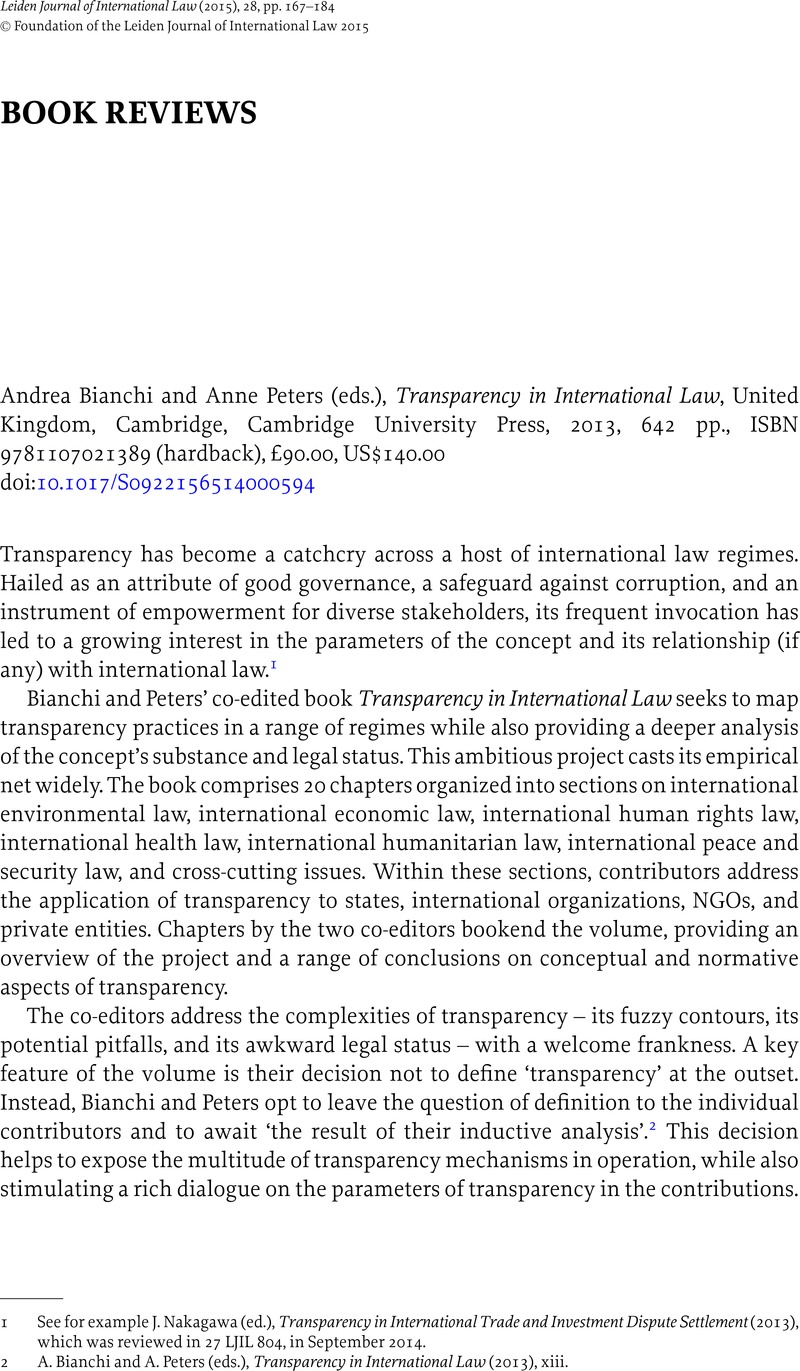Article contents
Andrea Bianchi and Anne Peters (eds.), Transparency in International Law, United Kingdom, Cambridge, Cambridge University Press, 2013, 642 pp., ISBN 9781107021389 (hardback), £90.00, US$140.00
Published online by Cambridge University Press: 27 January 2015
Abstract

- Type
- BOOK REVIEWS
- Information
- Copyright
- Copyright © Foundation of the Leiden Journal of International Law 2015
References
1 See for example J. Nakagawa (ed.), Transparency in International Trade and Investment Dispute Settlement (2013), which was reviewed in 27 LJIL 804, in September 2014.
2 A. Bianchi and A. Peters (eds.), Transparency in International Law (2013), xiii.
3 See, e.g., M. Donaldson and B. Kingsbury, ‘Power and the Public: The Nature and Effects of Formal Transparency Policies in Global Governance Institutions’, in Bianchi and Peters (eds.), supra note 2, 502 at 504.
4 For example, Sossai considers that in the field of disarmament and arms control, ‘transparency means State openness, to be achieved by way of voluntary notifications or compulsory declarations regarding the data on arms, policies and activities’: see M. Sossai, ‘Transparency as a Cornerstone of Disarmament and Non-proliferation Regimes’, in Bianchi and Peters (eds.), supra note 2, 392 at 393.
5 In the international environmental law context, Brunnée and Hey apply a broad approach to transparency as ‘“the opposite of secrecy”’ (citing Florini, A., ‘The End of Secrecy’, (1998) 111 Foreign Policy 50CrossRefGoogle Scholar, at 50, 53), focusing on the ideas of transparency of governance (the transparency of activities and procedures of international environmental institutions) and transparency for governance (the use of transparency as a policy instrument to influence an actor's conduct) (citing Mitchell, R. B., ‘Transparency for Governance: The Mechanisms and Effectiveness of Disclosure-based and Education-based Transparency Policies’, (2011) 70 Ecological Economics 1882CrossRefGoogle Scholar): J. Brunnée and E. Hey, ‘Transparency and International Environmental Institutions’, in Bianchi and Peters (eds.), supra note 2, 23 at 25.
6 A. Tzanakopoulos, ‘Transparency in the Security Council’, in Bianchi and Peters (eds.), supra note 2, 367 at 374–5, noting c.f. D. Hovell, ‘The Deliberative Deficit: Transparency, Access to Information and UN Sanctions,’ in J. Farrall and K. Rubenstein (eds.), Sanctions, Accountability and Governance in a Globalised World (2009), 92 at 97.
7 C. Creamer and B. A. Simmons, ‘Transparency at Home: How Well Do Governments Share Human Rights Information with Citizens?’, in Bianchi and Peters (eds.), supra note 2, 239 at 240, citing Mitchell, R. B., ‘Sources of Transparency: Information Systems in International Regimes’, (1998) 42 International Studies Quarterly 109CrossRefGoogle Scholar, at 109, which refers to ‘the acquisition, analysis, and dissemination of regular, prompt, and accurate regime-relevant information’.
8 A. Peters, ‘Towards Transparency as a Global Norm’, in Bianchi and Peters (eds.), supra note 2, 534 at 534.
9 Transparency, participation and effective review are three of the elements addressed in global administrative law, along with reasoned decision and legality. See Kingsbury, B., Krisch, N., and Stewart, R. B., ‘The Emergence of Global Administrative Law’, (2005) 68 Law & Contemporary Problems 15Google Scholar, at 17.
10 See, e.g., J. A. Maupin, ‘Transparency in International Investment Law: The Good, the Bad and the Murky’, in Bianchi and Peters (eds.), supra note 2, 142 at 149.
13 S. R. Ratner, ‘Behind the Flag of Dunant: Secrecy and the Compliance Mission of the International Committee of the Red Cross’, in Bianchi and Peters (eds.), supra note 2, 297 at 304.
14 A. Bianchi, ‘On Power and Illusion: The Concept of Transparency in International Law’, in Bianchi and Peters (eds.), supra note 2, 1 at 3, 5–6.
15 Ibid., at 6.
16 Lowe, A. V., ‘The Politics of Law-Making: Are the Method and Character of Norm Creation Changing?’, in Byers, Michel (ed.), The Role of Law in International Politics: Essays in International Relations and International Law (2000), 207Google Scholar at 221.
17 Bianchi, supra note 14, at 7.
18 Tzanakopoulos, supra note 6, at 385.
19 A. Boyle and K. McCall-Smith, ‘Transparency in International Law-Making’ in Bianchi and Peters (eds.), supra note 2, 419 at 430.
20 Donaldson and Kingsbury, supra note 3, at 515, 533.
21 Peters, supra note 8, at 585–6.
22 Ibid., at 536.
23 Maupin, supra note 10, at 166.
24 Peters, supra note 8, at 535, 605.
- 1
- Cited by




